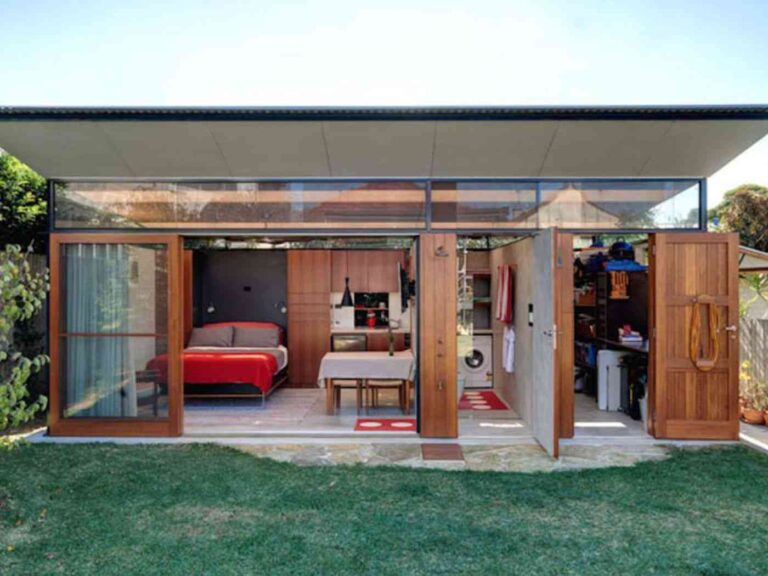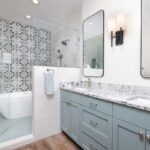It’s no secret that Australia is experiencing a housing affordability crisis which has savvy homeowners rethinking how to use their land.
With the rising cost of property, changing lifestyles, and a growing need for flexible spaces, many are exploring ways to add value and functionality to their backyards.
Two of the most popular options are backyard studios and granny flats.
At first glance, the two might look similar – both are small, standalone buildings often tucked neatly into the backyard.
But in practice, they serve very different purposes and are subject to different rules.
Understanding the difference between them can save you time, money, and a fair bit of frustration when planning your build.
What Is a Backyard Studio?
A backyard studio is a detached space built on a residential property, primarily intended for non-habitable use.
In other words, it’s designed for working, hobbies, or relaxation rather than for permanent living.
You’ll often see backyard studios used as:
- A home office or creative studio for artists, designers, or remote workers.
- A gym or yoga retreat, offering a quiet escape from the main house.
- A music room, games room, or teen hangout space.
- A guest room for occasional overnight stays (depending on approval and amenities).
In essence, it’s an extension of your lifestyle rather than a separate home.
Backyard studios have become particularly popular since the rise of remote work and home-based businesses in Australia, allowing homeowners to separate work and personal life without leaving the property.
What Is a Granny Flat?
A granny flat, on the other hand, is a self-contained secondary dwelling.
It includes everything someone would need to live independently – a bedroom, bathroom, kitchen or kitchenette, and living space.
Granny flats are commonly used for:
- Elderly parents or relatives, allowing families to live close together while maintaining privacy.
- Adult children saving for their own home.
- Rental income, offering a steady return on investment in Australia’s tight housing market.
- Guest accommodation or short-term rentals (in some council areas).
Unlike backyard studios, granny flats are designed and approved for permanent living, which means they must meet strict building codes and council regulations.
Key Differences at a Glance
| Feature | Backyard Studio | Granny Flat |
| Purpose | Non-habitable use (work, recreation, hobbies) | Habitable secondary dwelling for permanent living |
| Facilities | Typically lacks a full kitchen and laundry | Includes kitchen, bathroom, and living area |
| Size | Usually smaller and more flexible | Up to 60–80m² (varies by state) |
| Council Approval | Often simpler or may be exempt (depending on use and size) | Requires formal approval and compliance with building codes |
| Connection to Services | May share power and lighting only | Must connect to water, power, sewerage, and drainage |
| Rental Use | Not permitted for long-term rental | Can be legally rented out |
| Value Impact | Adds lifestyle appeal | Adds both lifestyle and financial value |
Council Regulations: What You Need to Know
Regulations differ from state to state, and even from one council area to another. Generally speaking:
Backyard Studios
Most backyard studios are classed as non-habitable structures under the Building Code of Australia (BCA). This means:
- They can’t include a full kitchen or laundry.
- They can’t be rented or used as a permanent residence.
- In many cases, they don’t require full development approval if they meet certain size and setback requirements.
For example, in Queensland, many local councils allow small backyard studios (often under 10m²) to be built without planning approval, provided they comply with distance and height restrictions.
Larger studios usually need building approval, but the process is still much simpler than that for a granny flat.
Granny Flats
Granny flats, also known as secondary dwellings, require a higher level of compliance.
Most Australian councils limit their size to between 60 and 80 square metres, depending on the zoning of the property.
In Queensland, the Gold Coast City Council and Brisbane City Council both permit granny flats on low-density residential lots, provided:
- The property meets the minimum lot size.
- The granny flat doesn’t exceed the maximum allowable area.
- The flat shares utilities with the main dwelling.
- Access, privacy, and parking requirements are met.
Unlike studios, granny flats must pass building certification to ensure they’re suitable for habitation, with adequate fire separation, ventilation, insulation, and accessibility.
Cost Comparison
The cost difference between a backyard studio and a granny flat can be significant.
- Backyard studios generally cost between $20,000 and $80,000, depending on size, finish, and whether plumbing or air conditioning is included. A simple, prefabricated studio pod or modular design can even be installed in a few days.
- Granny flats, however, are more complex structures. The price for 1 bedroom granny flats typically starts at around $120,000 and can exceed $200,000 for larger or custom-built versions. Costs rise due to additional features such as kitchens, bathrooms, and compliance with residential building codes.
While granny flats are a larger investment, they also offer greater long-term value through rental income or multi-generational living.
Flexibility and Lifestyle Use
If your goal is to create extra space for your lifestyle rather than a new home, a backyard studio might be the ideal choice.
They’re perfect for those wanting a peaceful work-from-home area, a hobby space, or a small retreat.
Because studios can often be built without major council approvals, the process is faster and less stressful. They also allow for creative freedom in design – you can use timber cladding, bold colour palettes, or even incorporate large glass panels to bring the outdoors in.
On the other hand, granny flats provide a more long-term and flexible investment. You can use them for family today and rent them out tomorrow.
They suit those wanting to add value to their property while keeping options open for future income or family use.
Design and Construction Considerations
Both backyard studios and granny flats can be designed to complement the existing home, especially in coastal regions like the Gold Coast or Northern NSW.
Popular design trends include:
- Light, open-plan layouts to make small spaces feel bigger.
- Natural materials like timber, stone, and fibre cement for a relaxed, Australian look.
- Energy-efficient design using insulation, shading, and cross-ventilation.
- Outdoor decks and landscaping to enhance liveability.
Prefab and modular designs have made it easier to achieve high-quality finishes on a budget.
Many Australian companies now offer customisable studio pods and granny flats that can be installed in weeks rather than months.
Return on Investment
From a financial perspective, granny flats generally offer the stronger return.
A well-designed and legally approved granny flat can:
- Increase your property value by 10–30%.
- Generate rental returns of $400–$700 per week, depending on the area.
- Provide ongoing flexibility as family needs change.
Backyard studios, while not rentable, still deliver strong lifestyle returns. They can:
- Increase the functional value of your property.
- Appeal to future buyers looking for home office space.
- Enhance property aesthetics and create a sense of retreat.
Both options, if designed well, make your property more attractive and adaptable in an ever-changing housing market.
Which One Is Right for You?
Ultimately, the decision between a backyard studio and a granny flat depends on your goals, budget, and long-term plans.
Choose a backyard studio if you:
- Want an affordable, fast project with minimal red tape.
- Need a workspace, gym, or hobby retreat.
- Don’t plan to rent the space out.
- Value design freedom over compliance complexity.
Choose a granny flat if you:
- Need a fully self-contained living space.
- Want to accommodate family members or generate rental income.
- Have the budget and space to meet council regulations.
- See it as a long-term investment in your property’s value.
Final Thoughts
In the world of Australian backyard design, both backyard studios and granny flats represent smart, space-conscious living.
One focuses on lifestyle and flexibility, the other on functionality and financial return.
If you’re looking to build on the Gold Coast, Brisbane, or anywhere along Australia’s eastern seaboard, take the time to understand your local council’s rules before you begin.
What might seem like a simple garden studio could, with a few design tweaks and approvals, become a high-value granny flat.
Whichever path you choose, these small but mighty structures prove that big ideas don’t always need big spaces.
Sometimes, the best way to expand your home is to step just a few metres into the backyard.



